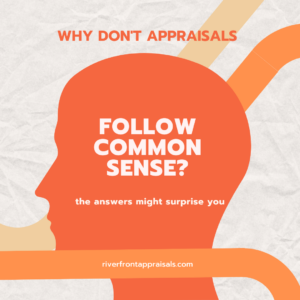
Property Taxes Just Went Up? We’ve Got You Covered!
It’s reassessment season for most folks in our area. Homeowners

Have you ever had a listing that didn’t appraise for contract price? It’s frustrating, for sure – especially if you feel like you don’t have any options! The home didn’t appraise for contract price, so the deal is dead, right? Not at all! When this happens, most parties have three options: lower the sale price to the appraised value, have the buyer come out of pocket for the difference, or cancel the sale. But those are all options you’ll need to consider after challenging the appraisal.
A Common Scenario
You took a brand new listing in a hot market, and priced it aggressively. You know it’ll set the top of the market if it sells, but things have been selling so high lately, you decide to push the price just a bit. You list the home at $399,900 and the appraisal comes back at $375,000. It’s disappointing. Frustrating. Confusing. Trust me, I’ve been there.
When I sold my last home, the appraiser came in and told me to my face, “Oh, there won’t be any problem. I’ve got comps for this house all day long”. And not surprisingly, our appraisal ended up coming back short of the sale price. So I know. It’s not fun.
Sometimes when a home doesn’t appraise for the price a buyer & seller have agreed upon, a deal can completely fall through.
However, if you have the time, before exploring your other options (see below), it never hurts to contact the appraiser. There’s no guarantee that the appraisal will be changed, but going about it in the right way will definitely increase your chances. We call this a reconsideration of value request. Now one quick caveat before we get into the details. Not all banks or mortgage companies allow reconsideration requests. Most do, but some do not. Just keep that in mind.
So what exactly is the ‘right way’ to go about a reconsideration of value request?
Steps for a Reconsideration of Value
What I’m trying to not encourage you to do is this: after you get a call from the bank saying the appraisal came in $5,000 under contract price, you immediately fly off the handle and call the appraiser to chew her out. I would not recommend this!
What does that mean, “If done right”?
The sales you provide to the appraiser need to be as comparable or more comparable than the sales already in the report. Here’s what I mean by that. Let’s say your listing is a 2,400 square foot Cape Cod-style home with no basement. The sales used in the appraisal ranged from 2,000 – 3,000 square feet and all sold within the last six months. If the alternate sales you provide are all over 3,000 square feet, and all sold substantially higher than your listing, then it’s likely that the appraiser won’t even consider them. You see, the appraiser needs to have a compelling reason to include alternate sales you provide. Don’t go out and just find the highest priced sale you could find. Also, if the sales the appraiser used all sold in the last six months, and you provide a 12-month old sale only because it sold much higher, then the appraiser will probably not use that sale.
So when you provide alternate sales, make sure & include commentary that explains why your sales are more comparable to the subject property than the sales used by the appraiser.
And finally….
When you find yourself needing to request a reconsideration of value (and trust me – you will!), feel free to use the free template we created, called, Reconsideration of Value Request. You can find it at riverfrontappraisals.com; hover over “The Appraisal Blog” and click on Resources.
What if none of this works?
If you’ve followed the steps above and it hasn’t changed anything, you have a few options. All is not lost!
Option 1: Lower the sale price to the appraised value.
Sometimes, if the difference in sale price and appraised value is minimal, a seller will simply lower the sale price to reflect the appraisal. Say your listing was under contract at $150,000 and the appraisal came back at $140,000. Maybe the seller just lowers the price to $140,000 to get the deal done. They take less than they thought they were going to get, and the buyer gets the home for a price they’re comfortable with. The home is sold. Everyone moves on. And everyone is (mostly) happy.
Option 2. The buyer comes out of pocket for the difference.
Sometimes a seller won’t budge off the contract price (you’ve had one or two of those, I’m sure!), even after an appraisal comes in below contract. “I’m the seller, and we agreed to $600,000, and I won’t take one single penny less!”
Now if the buyer is obtaining financing in order to purchase the home, the bank will likely only be lending a percentage of the sale price. If the sale price is $100,000, and it appraises at $100,000, and the bank will lend 80% of that, then the buyer has $80,000 from the bank and has to come up with a $20,000 down payment.
But suppose the home only appraises for $90,000. Now, the lender will only loan $72,000 ($90,000 x 80%). That means if the seller isn’t willing to lower the price, the purchase has to pony up an additional cash on top of the 20 grand they were originally expecting to pay. That could be a deal breaker for some.
Option 3. The sale is canceled.
This is the worst-case scenario. The seller won’t budge, and the buyer is strapped for cash. So what do you do? If a meeting of the minds can’t be reached, you simply void the contract, go look for another buyer for your listing, or home for your buyers.
Hopefully you never make it to this last option. Try completing a reconsideration of value first, if the lender will allow it. And then, your gifts of negotiation come in and hopefully the deal survives! If you have any questions about a reconsideration of value, no matter what part of the country you’re from, reach out to me anytime at ryanbays@riverfrontappraisals.com. I’m always happy to help!
Committed to helping you understand your home’s market value,
Ryan Bays, SRA, AI-RRS

It’s reassessment season for most folks in our area. Homeowners

I feel like we all need a laugh. How about

So this may be a slight break from the norm,
Riverfront Appraisals has been providing comprehensive valuations of residential properties to Western Kentucky and Southwestern Indiana since 2008.